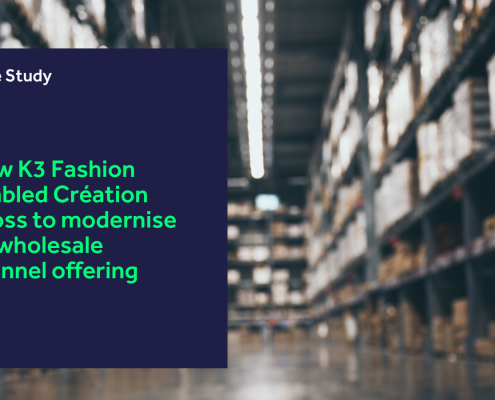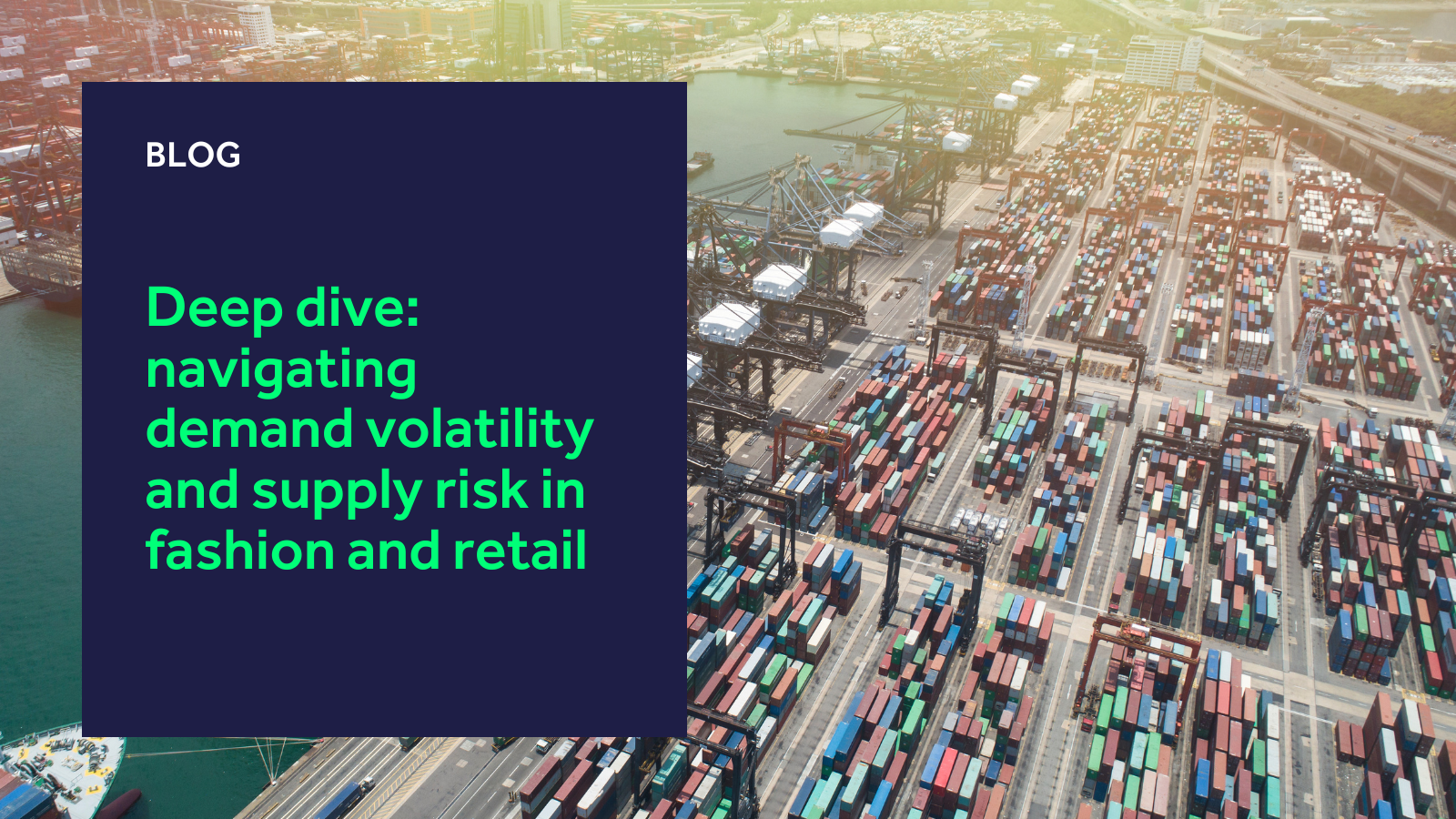The pandemic brought many challenges for brands and businesses across the globe, but perhaps none more significant than the persistent supply chain disruptions that have caused countless issues in every industry.
Such disruptions have resulted in material shortages, long lead times, transportation bottlenecks and a massive rise in shipping costs. While it was indeed the pandemic that catalysed many of these disruptions, there are several other factors that have greatly impacted business’ bottom lines.
These factors include shipping disruptions (congested ports, lack of containers, and harbors being temporarily shut) through to raw materials shortages (in part due to a slowed flow of supply from China) to name but a few.
Rising costs are squeezing brands and consumers alike
While the myriad challenges faced by fashion and retail brands are different in nature, they have mostly all caused two key problems for businesses: demand volatility and supply risk.
Both throughout and after the pandemic, consumers released their pent-up spending power to treat themselves which led to a huge boom in sales – particularly online. This naturally caused a strain on production and transport capacities, which subsequently forced businesses to reassess their processes.
Flash forward to today and, in the wake of Brexit, the rising cost-of-living crisis and escalating geopolitical tensions, consumers are now drastically reining in their spending and cutting out unnecessary purchases.
Even the biggest brands, like Boohoo, have felt the impact of this. The online fashion retailer reported a 94% year-on-year fall in its pre-tax profits in the year up to March 2022. Reports suggest this was the result of both rising costs and falling demand.
Events such as these highlight how it is becoming increasingly difficult to accurately forecast demand which is in turn creating supply risk. In today’s economic climate, businesses simply cannot afford to over purchase a product and waste precious resources.
And if that wasn’t enough, businesses and consumers alike are also being forced to reckon with sky high transportation costs.
Last year, the United Nations Conference on Trade and Development’s (UNCTAD) Review of Maritime Transport report revealed that consumers could expect to be hit with a price rise of 10% on products to account for the rise in freight rates. It was noted that clothing and textiles were particularly at high risk of having price rises linked to higher shipping costs.
According to UNCTAD, consumers spent the majority of their money on goods rather than services throughout the pandemic. This dramatic swing in containerised trade flows was ultimately met with devastating supply-side capacity constraints (i.e. container shortages, labour shortages, on and off restrictions across port regions due to COVID-19).
The mismatch between surging demand and reduced supply ultimately led to container freight rates soaring across nearly all container trade routes.
In fact, UNCTAD’s analysis showed that the surge in container freight rates, if sustained, could increase global import price levels by 11% and consumer price levels by 1.5% until 2023.
Brands are shifting production and manufacturing overseas
In the midst of all the current economical and geopolitical disruptions, businesses have started to explore alternatives, like nearshoring and offshoring, as a means to prevent such catastrophes from occurring again in the future.
The rise in both nearshoring and offshoring has largely been spurred by the burgeoning need to achieve greater agility and flexibility within the supply chain to mitigate demand volatility and supply risk.
At present, China remains the world’s manufacturing hotspot and supply chain hub. However, with wages in China increasing, on average, 10% per year, paired with rising costs around the world, many businesses have started to explore elsewhere.
Some brands, like Italy’s Benetton, have found success in bringing production back closer to home by manufacturing more in Serbia, Croatia, Turkey, Tunisia and Egypt.
“It’s a strategic move to have more control on the production process and also on transport costs,” said Chief Executive Massimo Renon to Reuters in late 2021. “Today, a shipping container that used to cost $1,200 to $1,500 can cost $10,000 to $15,000 with no certainty of a delivery date.
“The tenfold jump in sea freight costs has been driven by a scarcity of available vessels, as many were idled during the pandemic, coupled with rebounding consumer demand.”
Renon later added that even if production costs remained 20% lower in Vietnam and Bangladesh, compared to Mediterranean countries, the benefit was offset by longer lead times instigated by supply chain woes.
Yet, while some brands like Benetton have found success in moving their manufacturing processes closer to home, others have not.
H&M, for example, began moving its production activities away from China and setting up shop in Southeast Asian countries like Bangladesh, Vietnam, Malaysia and Indonesia. But the logistics network established in China has proven to be superior than in other regions.
While there are some advantages to shifting towards Southeast Asian countries, it’s becoming clear that these regions still do not have the same level of infrastructure needed for it to be a viable avenue for businesses.
Evidently, there is no silver bullet or one size fits all solution that will allow businesses to optimise their manufacturing and production processes.
What is obvious, however, is that businesses need to start analysing their supply chains and future proofing them to ensure major events, like the pandemic, don’t have the same level of impact on their operations again.
How can brands future proof the supply chain?
In today’s volatile climate, brands must look to future proof their supply chains to help bolster their agility, flexibility and reliability.
Fortunately, there are several steps that brands can take to help regain control over their processes. These are as follows:
- Allocate product to different vendors and allow developers to find both nearshore and remote sources.
- This would enable developers to identify products that can be made nearby as well as products that are too expensive or complex for nearshoring.
- Items could then also be developed at multiple factories in different geographies to increase flexibility.
- Achieve greater control over critical raw materials and transactions without necessarily actually owning the materials.
- By having greater control over critical raw materials, it becomes significantly easier to change factories while materials are being produced to further boost agility.
- Split large volume orders of items between multiple suppliers in different geographies to further help increase control and avoid delayed deliveries.
- Utilise efficient warehouse allocation rules to ensure critical customers and retail stores get a partial first delivery against their orders, while awaiting the remainder of the order.
- Combine multiple production sources to help distribute purchase orders more efficiently and start fulfilling sales orders on the promised dates.
- This will also ensure that short shipments will be less painful to manage.
- Consider “what-if” cost scenarios, taking into account split order quantities over multiple sources, to negotiate the right purchase prices and determine the correct sales price.
- Conduct open cost calculations to understand the cost down to the raw materials levels.
- Combine pre-allocation calculations and the ability to play logistics scenarios, prior to any shipment taking place, to help understand what percentage of the purchase orders should be shipped in what manner.
- This will drastically assist with fulfilling wholesale and retail demand based on criticality and profitability.
It’s important that brands seriously consider these options and evaluate which one best suits their business to help secure their supply chains in the long-term.
However, they would also be wise to not underestimate the significance of having digital tools that offer greater visibility into their operations.
For example, knowing that a vendor in China offered a lower price but a higher lead time, while another vendor in Turkey had a higher price but shorter lead time, could significantly influence a brand’s decision on which vendor to choose.
Efficient digital tools and the skills to implement them are key
With the right solutions, and the skills to implement them, businesses can accurately identify areas in their operations which can be optimised to further save costs.
This is particularly important, especially when considering that over the last decade, UK retail sales have risen by 35.7% yet profits have actually fallen by 10.9% – highlighting just how badly inflation and other issues are hitting brands.
To start optimising operations and tightening profit margins, brands will need digital tools to help them analyse their costs, highlight inefficiencies, and allow them to plan accordingly.
Yet, a lack of digital tools supporting efficient product development and sourcing processes ranks as the top hurdle when it comes to implementing solutions that can manage demand volatility and supply risk.
To make matters more complicated, the fourth highest barrier to mitigating demand volatility and supply risk lies in brands’ internal skill gaps to fully implement the digital tools necessary to curb these issues.
Clearly, not only do businesses require more efficient digital tools, but also a partner that can implement them.
K3’s solutions and extensive partner network can play a vital role here. For example, our Cargo Management solution allows businesses to seamlessly access key information about their vendors, transport routes, dates, and other essential documentation.
With this visibility, it becomes very easy to update purchase order details, inform customers about changes, maximise efficiency and reduce costs down the line.
Likewise, our Landed Cost solution enables businesses to calculate expenses (like freight rates, tariffs, insurance, import duties etc.) with easy to use calculation templates and worksheets.
What this crucially allows them to do is determine what price to assign their products in order to turn a profit once they’ve been sold.
And since we have a global partner network, there’s never a shortage of highly trained individuals ready to implement both Cargo Management and Landed Cost into your business and provide support whenever necessary.
If you’d like to learn more about Cargo Management and Landed Cost, feel free to drop us a line today to get more information!
 https://www.k3btg.com/wp-content/uploads/2023/11/Creation-Gross-blog-header.png
900
1600
Jordan Heal
https://www.k3btg.com/wp-content/uploads/2022/03/K3_Master_Colour_RGB.svg
Jordan Heal2023-11-10 10:09:412025-02-21 14:46:42How K3 Fashion enabled Création Gross to modernise its wholesale channel offering
https://www.k3btg.com/wp-content/uploads/2023/11/Creation-Gross-blog-header.png
900
1600
Jordan Heal
https://www.k3btg.com/wp-content/uploads/2022/03/K3_Master_Colour_RGB.svg
Jordan Heal2023-11-10 10:09:412025-02-21 14:46:42How K3 Fashion enabled Création Gross to modernise its wholesale channel offering

